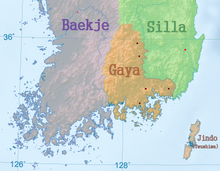Gaya
|
History of Korea to the 10th Century |
|---|
| Prehistoric Korea |
|
| Antiquity |
| Proto-three realms |
| Time of the Three Kingdoms |
| Northern and Southern states |
|
| Later three realms |
|
Gaya ( Kor. 가야 , Hanja 加 倻 , rev. Gaya , pronunciation ɡ ~ ɣaja ) was a confederation of tribes in the central south of the Korean Peninsula from 42 AD to 562 AD . Historians traditionally estimate the period of Gaya from 42 AD to 532 AD ( Geumgwan Gaya ). After archaeological excavations, however, complex tribal estates of Byeonhans developed into the Gaya Confederation in the third and fourth centuries . This was later conquered by Silla .
History of Gaya
The origin of the tribal confederation can be traced back to the Samhan confederations. Gaya belonged to the Byeonhan tribal association. This, and thus also Gaya, existed on the lower reaches of the Nakdong in the central south of the Korean Peninsula and between the kingdoms of Baekje and Silla .
The Gaya Confederation was first led by the Geumgwan Gaya tribe in Gimhae and later by the Dae Gaya tribe in Goryeong. Since it was soon taken by Silla, it is usually assigned to the Korea of the Three Kingdoms , Goguryeo , Baekje and Silla. Due to the rapidly changing political constellation on the Korean Peninsula, the Gaya states, wedged between Baekje and Silla, which soon fought and soon allied, apparently had no chance of developing into a viable kingdom.
Founding States
The founding states of the Gaya Confederation were Geumgwan Gaya , Ara Gaya , So Gaya and Dae Gaya . These states themselves were the successors of other small states:
- Geumgwan Gaya originated from Guya , a small state in what is now Gimhae and Busan .
- Ara Gaya originated from Anya , a small state of the Byeonhan Confederation. Its center can be found in today's Haman .
- So Gaya, also known as Gojaguk , developed in the area of what is now Goseong , Jinju and Dingon on the south coast of the Korean Peninsula.
- Dae Gaya originated in the small state of Ballo in what is now Goryeong County .
Meaning of gayas
Gaya was a center of international trade because of its rich iron deposits on the middle and lower rivers of the Nakdong; It delivered iron and other goods across the sea, for example to the Chinese Lelang headquarters or to Japan .
Gaya's political influence on the other three kingdoms of the Korean peninsula Goguryeo, Baekje and Silla was limited, also due to the early annihilation. Still, despite its short-lived nature, its cultural influence on Silla was significant. From his upper class, which was affiliated to the Silla aristocracy , personalities emerged who did great service for the unification of the peninsula under Silla's leadership.
various
Iron production
Gaya began to increasingly use iron instead of bronze for the production of everyday objects.
weapons
The hallmarks of Gaya's weapons include swords with a phoenix or dragon decoration on the pommel and sword pommel with a trefoil decoration. They must have served as social status symbols within the confederation.
Horse harness
Gaya's horse equipment was originally more practical than exquisite workmanship like the Sillas horse harness . But finely decorated pieces with Silla and Baekje influences were also found.
Pottery
Realistic clay figures of people and animals were often given to the deceased as companions in the grave. Some animal figures also served bowls and other vessels as decorations.
Jewellery
The jewelry Gayas and Mimanas includes bronze-gold-plated crowns with floral patterns, earrings, bracelets, rings and various chains made of glass.
Graves
Important figures of the Gaya period were buried in burial mounds . So far, around 780 grave mound clusters from the Gaya period have been identified by means of soil surveys, 104 of which have been extensively examined archaeologically. A selection of historically particularly important grave mound clusters were included in South Korea's list of proposals for inclusion in the UNESCO World Heritage Site in 2019 under the title Gaya Tumuli .
Mimana
The state of Gaya is a controversial topic in Japanese-Korean historical debates. Mohan (2016) describes the theory of a Japanese colony in the Gaya region as "the most consistent and influential portrayal of Japan's cultural and political hegemony". The traditional Japanese historiography that Gaya was a colony of ancient Japan is based on the Nihonshoki . At the same time, there are theories that there were Korean colonies in the Japanese archipelago.
Individual evidence
- ^ A b Gina Lee Barnes: State Formation in Korea: Historical and Archaeological Perspectives . Psychology Press, 2001, ISBN 0-7007-1323-9 , Introducing Kaya History and Archeology.
- ↑ a b c The Brockhaus in Text and Image 2003 [SW], electronic edition for Office Library, Bibliographisches Institut & FA Brockhaus, 2003; Article: "Korea until AD 668: State formation in the land of the morning calm"
- ^ A b Pankaj Mohan: The Controversy over the Ancient Korean State of Gaya: A Fresh Look at the Korea-Japan History War . In: Michael Lewis (Ed.): 'History Wars' and Reconciliation in Japan and Korea. The Roles of Historians, Artists and Activists . Palgrave Macmillan US, 2016, ISBN 978-1-137-54102-4 , pp. 107–124 , doi : 10.1057 / 978-1-137-54103-1_6 (English, limited preview in Google Book Search).
literature
- Chun-gil Kim: The History of Korea . Greenwood Publishing Group, 2005, ISBN 0-313-33296-7 , pp. 27–29 (English, limited preview in Google Book Search).
Web links
Coordinates: 35 ° N , 128 ° E


